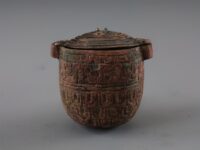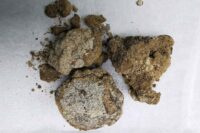 Analysis of a jar of face cream unearthed in an ancient tomb in northern China has revealed it was made of beef fat and minerals derived from white stalactites in limestone caves. Found in the tomb of a nobleman from the Spring and Autumn Period (ca. 771-476 B.C.), this face cream is the earliest evidence of use of cosmetics by a Chinese man.
Analysis of a jar of face cream unearthed in an ancient tomb in northern China has revealed it was made of beef fat and minerals derived from white stalactites in limestone caves. Found in the tomb of a nobleman from the Spring and Autumn Period (ca. 771-476 B.C.), this face cream is the earliest evidence of use of cosmetics by a Chinese man.
The cream was inside a small bronze jar discovered in tomb M49 at the Liujiawa archaeological site, capital of the Zhou Dynasty vassal state of Rui (700-640 B.C.). The tomb’s funerary furnishings included a set of bronze weapons identifying the deceased as a man of aristocratic class, and the ornately decorated bronze jar which was placed in the outer coffin near the man’s head. Just over two inches high, the vessel is u-shaped with two handles and a lid. The lid was still snugly sealed.
These types of vessels have been found before in tombs from the Early Spring and Autumn period, and archaeologists have hypothesized that they held cosmetics, but it could not be confirmed scientifically. The discovery of a sealed jar made it possible to analyze the contents to determine whether they were indeed cosmetics.
 When the jar was opened in laboratory conditions, it was found to contain lumps of a yellowish-white material. The substance was analyzed with a variety of technologies including mass spectrometry, X-Ray diffraction, isotope analysis, acid extraction and scanning electron microscopy. The results revealed that the white particles consist primarily of monohydrocalcite (MHC) while the yellowish element was a lipid. MHC is mostly found in lake deposits or caves, and the isotope values pointed to the latter. Analysis of the fatty acids in the lipid sample identified it as ruminant animal fat, likely bovine.
When the jar was opened in laboratory conditions, it was found to contain lumps of a yellowish-white material. The substance was analyzed with a variety of technologies including mass spectrometry, X-Ray diffraction, isotope analysis, acid extraction and scanning electron microscopy. The results revealed that the white particles consist primarily of monohydrocalcite (MHC) while the yellowish element was a lipid. MHC is mostly found in lake deposits or caves, and the isotope values pointed to the latter. Analysis of the fatty acids in the lipid sample identified it as ruminant animal fat, likely bovine.
MHC in a soft mud form known as cave moonmilk was harvested from limestone caves, perhaps as part of Taoist ritual. Caves held symbolic significance as the womb metaphors and stalactites were believed to have been formed from the liquid souls of hills. The glossy whiteness of the best stalactites were compared to the most precious jade and valued for their medical as well as cosmetic properties. Stalactites and moonmilk were collected, ground, dried and processed to create the most pure powders.
Cosmetic manufacturing had already become a specialized industry for the supply to the nobility in the early stage of the Spring and Autumn Period, and the involvement of a sorcery/alchemy‐related ingredient (e.g., the collection of cave minerals) enriched the aestheticism with mystic elements. In fact, historical records from the pre‐Qin period described face whitening through cosmetic use as a source of cultural pride. The whitened face with unnatural complexions could conceal defects on the skin and mask a layer of luminous homogeneity, enhancing the facial bilateral symmetry in contrast with the black eyelashes and black hair. Also, the whitened face eliminates wrinkles, creating an identity of youthfulness and beauty with a manner of majestic which is appealing to the aristocratic class.
Another interesting point lies in the male’s use of white cosmetics, which has scarcely been described since the Spring and Autumn Period (mostly female figures were described). In accord with our findings, historical records also suggested the pre‐Qin period (pre‐221 bce) was an emerging era for white makeup cosmetics advocating facial attractiveness with white luminance. This aesthetic taste of the aristocratic class involving cave minerals reflected the increasing awareness of aesthetics and metaphysics in the Spring and Autumn Period that had influenced the subsequent aesthetic taste in history. […]
Residue analysis verifies the earliest cosmetic cream product in China: not only has it pushed back the historical description for cosmetic use of ruminant adipose fat (most likely cattle fat) to the early phase of the first millennium bce, but also it highlighted the special MHC use resulting from the exploitation of cave minerals along with the Taoist School Cave Cultus which adds mystic elements to the aestheticism of cosmetics. The special ingredients and the popularization of similar bronze vessels disclosed the rise of an incipient cosmetics industry in the Spring and Autumn Period which still acts as an important part of our daily life. This archaeological residue study showed that apart from being a culinary ingredient, animal products were also explored in the handcraft industry of cosmetics‐making. It has also deepened our knowledge of natural mineral usage, revealing a special aesthetic taste in the early Iron Age of ancient China and has contributed to the worldwide study of cosmetics development.
The comparative readability of that long quote from a Chinese source puts google’s free translation service to shame.
But, it’s still awkward to read as if vicar had had a touch too much gin and was trying his best to seem erudite for his learned parishioners.